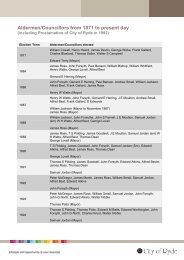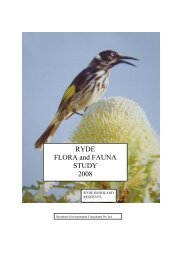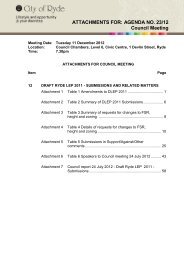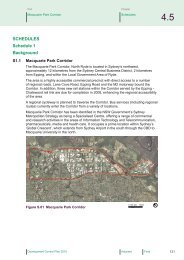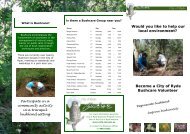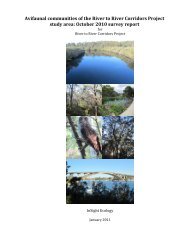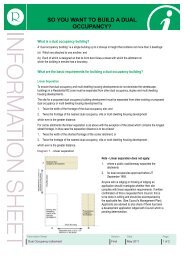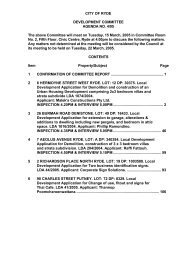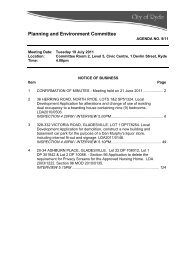RYDE FLORA and FAUNA STUDY 2007 - City of Ryde - NSW ...
RYDE FLORA and FAUNA STUDY 2007 - City of Ryde - NSW ...
RYDE FLORA and FAUNA STUDY 2007 - City of Ryde - NSW ...
You also want an ePaper? Increase the reach of your titles
YUMPU automatically turns print PDFs into web optimized ePapers that Google loves.
Biosphere Environmental Consultants Pty Ltd<br />
<strong>Ryde</strong> Flora <strong>and</strong> Fauna Survey <strong>2007</strong> 58<br />
None <strong>of</strong> these habitats are alien to the <strong>Ryde</strong> area, <strong>and</strong> some would require the<br />
procurement <strong>of</strong> seed stock from nearby bushl<strong>and</strong> areas as parent plants no longer exist<br />
in the <strong>Ryde</strong> LGA.<br />
Finally, with so much information now available about the flora <strong>and</strong> fauna <strong>of</strong> the<br />
bushl<strong>and</strong> reserves, a structure needs to be developed so that this information can be<br />
overviewed <strong>and</strong> a co-ordinated response achieved. <strong>Ryde</strong> <strong>City</strong> Council already has a<br />
“Parks on Track” Plan for its reserves <strong>and</strong> the new information needs to be<br />
assimilated so that planning decisions can be made with all <strong>of</strong> the available<br />
information at h<strong>and</strong>.<br />
6.2 Improving the Habitat Value <strong>of</strong> Existing Reserves<br />
The existing bushl<strong>and</strong> reserves suffer from a loss <strong>of</strong> terrestrial fauna. In many cases<br />
this is due to predation by foxes, cats, dogs, black rats or native birds. The bushl<strong>and</strong><br />
reserves that are established along watercourses tend to be long <strong>and</strong> narrow, making<br />
them even more prone to feral animal entry. Predation has taken a heavy toll because<br />
there is a lack <strong>of</strong> shelter sites in the reserves. Dead trees, fallen logs <strong>and</strong> branches <strong>and</strong><br />
rocks usually provide the best shelter habitat along with understorey plants. In many<br />
reserves the understorey is still present (albeit not completely intact) but there is a<br />
shortage <strong>of</strong> logs <strong>and</strong> fallen timber. In other instances they have been removed because<br />
they look messy or block tracks. Dead trees are only felled where they are considered<br />
a danger to walkers close to tracks <strong>and</strong> private property.<br />
The lack <strong>of</strong> ground shelter is a major impediment for the survival <strong>of</strong> many native<br />
terrestrial species. This situation does not prevent the use <strong>of</strong> artificial shelters for<br />
terrestrial animals. Although this is not a widely accepted practice, animal shelters in<br />
trees have been used for parrots <strong>and</strong> possums. These tree shelters replace the dead tree<br />
hollows that are lost from reserve habitats.<br />
6.3 Connectivity <strong>of</strong> Bushl<strong>and</strong> Areas<br />
As the residential areas in <strong>Ryde</strong> were developed, bushl<strong>and</strong> pockets became smaller<br />
<strong>and</strong> more isolated. The isolation <strong>of</strong> bushl<strong>and</strong> area makes them even more susceptible<br />
to urban impacts <strong>and</strong> biota loss. An aim in the conservation <strong>of</strong> remnant buhsl<strong>and</strong> area<br />
should be to try to increase the connectivity <strong>of</strong> these sites.<br />
Some <strong>of</strong> the bushl<strong>and</strong> reserves e.g Memorial Park, are totally isolated from other<br />
bushl<strong>and</strong> areas. This isolation diminishes the survival prospects <strong>of</strong> various animals<br />
<strong>and</strong> limits the capacity <strong>of</strong> migratory species to use the reserves while moving across<br />
Sydney. To create corridors between reserves will require the creation <strong>of</strong> suitable<br />
habitat outside <strong>of</strong> the reserves. There appears to be two ways that this can be done:<br />
1. Sympathetic street planting. Instead <strong>of</strong> using ornamental or totally<br />
decorative street trees, trees that provide habitat value (either as dense canopy, food or<br />
nesting sites) should be utilised. As most <strong>of</strong> the reserves contain woodl<strong>and</strong>, the types<br />
<strong>of</strong> tree that would serve this purpose include Turpentine Syncarpia glomulifera,




